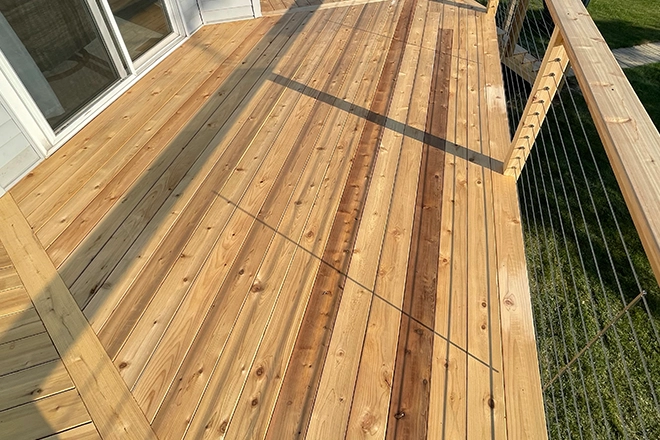Ever wonder why some decks last for years while others warp, cup, or grow mold?
Could something as small as the space between boards really make that much of a difference?
In this post, you’ll learn exactly how much space to leave between deck boards, plus what factors affect spacing—from the type of wood to your local weather.
By the end, you’ll be more confident in Hard Deck’s ability to install your deck.

What Is the Correct Deck Board Spacing?
Use 1/8″ to 1/4″ spacing for deck boards, depending on material and moisture. Kiln-dried wood needs 3/16″ for 4″ boards and 1/4″ for 6″. Air-dried wood requires tighter gaps of 3/32″ and 1/8″. Pressure-treated boards should be installed tightly. Follow manufacturer guidance for composite boards.
The right spacing between deck boards depends on the material and its moisture content. Most homeowners want their deck to look great and last for years—but even the best boards won’t perform well without proper gaps.
The short answer? You typically need 1/8″ to 1/4″ between boards. But that number can shift depending on what you’re working with.
For kiln-dried wood, which has already lost most of its moisture, plan for a 3/16″ gap for 4″ boards and 1/4″ for 6″ boards. These boards won’t shrink much, so leave space for swelling when they get wet.
If you’re using air-dried decking, you’ll need tighter spacing—3/32″ for 4″ boards and 1/8″ for 6″ boards—because it will likely shrink as it continues drying out.
With pressure-treated wood, the boards usually come soaked and shrink as they dry. The best approach? Install them tightly against each other. Once they dry out, they’ll naturally create about a 1/4″ gap.
Composite decking materials like wood, plastic, composite, or PVC boards expand and contract with changes in temperature. Follow the manufacturer’s recommended spacing carefully, especially around butt joints and edges.
Contact us today about installing your deck in Illinois.
Why Deck Board Spacing Matters
Getting the right spacing isn’t just about looks—it’s about function and safety. That small spacing gap between your deck boards does a few critical functions that help your deck perform better over time.
Moisture Movement and Wood Behavior
Wood naturally expands and contracts with humidity and weather changes.
Without proper deck board spacing, those movements can lead to cupping, buckling, or cracks in the boards. If boards are too tight, they may press against each other as the wood expands, putting pressure on fasteners or lifting up from the joists.
Drainage and Air Circulation
Decks live outside, which means they’re constantly battling rain, sun, and changing seasons.
Gaps between the boards let rainwater drain, keeping moisture off the deck surface. These gaps also encourage airflow between the boards and beneath the deck. This helps to prevent mold, rot, and the early breakdown of the decking material.
Safety and Surface Integrity
If the gaps are too wide or too tight, your deck surface could become a hazard.
Too-small gaps trap moisture and debris, making the surface slippery and dangerous.
Oversized gaps can trip people up, catch debris, or let small items fall through.
Balanced, even spacing gives you a safe and long-lasting deck.
Factors That Influence Proper Spacing
Wood Type and Moisture Content
Moisture content plays a big role in how boards behave.
- Kiln-dried boards are stable and shrink less after installation.
- Air-dried decking and pressure-treated wood start out wetter and will shrink over time.
Understanding your wood species also matters. For example, hardwood decking like ipe or cumaru is much denser and expands differently than traditional wood like cedar or pine.
Every deck material moves differently, so your deck spacing should match.
Board Width
Wider boards expand and contract more than narrower ones. A 6-inch board needs a slightly larger gap than a 4-inch board to handle its movement. Ignoring width can lead to uneven pressure on the deck surface or issues with drainage.
Local Climate Conditions
The weather conditions where you live—especially humidity and seasonal shifts—change how much your boards move. In wetter climates, decks see more expansion and contraction, so they need wider gaps. In dry climates, spacing can be tighter without issues.
Installation Timing
If you’re installing during a dry season and using wet boards, they’ll shrink as they dry. In contrast, installing in a humid season could lead to the boards swelling. Use a moisture meter to get accurate readings before installation. A board that feels dry to the touch might still have a high moisture content.
Best Practices for Spacing Deck Boards
Let Boards Acclimate Before Installation
If you’re using wood decking, let it rest on-site for 1 to 2 weeks so it can adapt to your area’s outdoor temperature and humidity. This prevents big shifts after the deck installation is complete.
Use a Moisture Meter
A simple moisture meter can tell you if your boards are ready to go. Aim for around 12% for kiln-dried lumber or 18% for air-dried decking before you start installing.
Choose the Right Spacers or Fasteners
Using deck spacers or gap guides helps you keep your spacing consistent across the entire deck surface. For composite decking, hidden fasteners are often part of the system and set the spacing for you.
Follow the Manufacturer’s Instructions for Composites
Each composite brand has different rules for thermal expansion, especially at butt joints, board ends, and the edges of the deck. PVC and wood plastic composite boards may expand along their length, so don’t treat them like wood boards.
The complete process of how to build a deck.
Spacing Tips by Material Type
Kiln-Dried Lumber
Plan for slightly larger gaps from the start. These boards are stable and won’t change much after installation. Space 3/16″ to 1/4″, depending on the board width.
Air-Dried Lumber
Expect these boards to shrink. You’ll want to space deck boards tightly so they open up to the ideal spacing over time.
Pressure-Treated Wood
Because of its high moisture content, this lumber should be installed tightly. After installation, let the natural drying process create your correct spacing.
Composite and PVC Decking
Composite decking may look like wood, but it contracts differently and needs a different approach. Always follow product-specific guidelines, especially around temperature ranges and butt joints.
Common Spacing Mistakes to Avoid
Skipping Acclimation
Installing right away without letting the boards rest can cause unwanted movement after the fact. This is especially risky with wood decking.
Overlooking Climate Effects
What works in one area might not work in another. Your local climate shapes the right spacing for your deck.
Using the Same Spacing for All Materials
You can’t treat composite, pressure-treated, and hardwood decking the same. Each requires its own approach to board spacing and installation.
Inconsistent Installation
When you eyeball gaps or skip tools, your spacing becomes uneven. This can lead to drainage problems, weak spots, and an uneven deck surface that doesn’t last.
Should you DIY your deck or hire a pro?
Mind the Gap and Let Hard Decks Handle the Rest
At Hard Decks, we know that a strong, lasting deck starts with the details, like perfect deck board spacing. Whether you’re using traditional wood, composite decking, or something in between, we build with precision and care from the first board to the final screw.
Ready to get started on your next outdoor project in Illinois? Call us at +1 (815) 706-4648 or fill out our contact form today, or give us a call to talk about building a deck that’s made to last.
